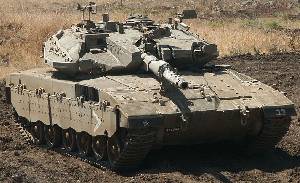
Sloped armour is armour that is mounted at a non-vertical and non-horizontal angle, typically on battle tanks and other armoured fighting vehicles.
For a given normal to the surface of the armour, its plate thickness, increasing armour slope improves the armour's level of protection by increasing the thickness measured on a horizontal plane, while for a given area density of the armour the protection can be either increased or reduced by other sloping effects, depending on the armour materials used and the qualities of the projectile that hits it. The increased protection caused by increasing the slope while keeping the plate thickness constant, is due to a proportional increase of area density and thus mass, and thus offers no weight benefit. Therefore the other possible effects of sloping, such as deflection, deforming and ricochet of a projectile, have been the reasons to apply sloped armour in armoured vehicles design. Another motive is the fact that sloping armour is a more efficient way of covering the necessary equipment since it encloses less volume with less material. The sharpest angles are usually seen on the frontal glacis plate, both as it is the hull side most likely to be hit and because there is more room to slope in the longitudinal direction of a vehicle.
Sloped armour was first widely used in the Soviet-designed T-34 battle tank and is also widely used in modern main battle tanks. A good example of that is the turret of the Israeli Merkava main battle tank.